Рынок технического обслуживания электромобилей: текущий анализ и прогноз (2024-2032 гг.)
Акцент на тяговую установку (аккумуляторные электромобили, подключаемые гибридные электромобили, гибридные электромобили и электромобили на топливных элементах); компоненты (механические, электрические и другие); тип транспортного средства (легковой автомобиль и коммерческий транспорт); и регион/страна
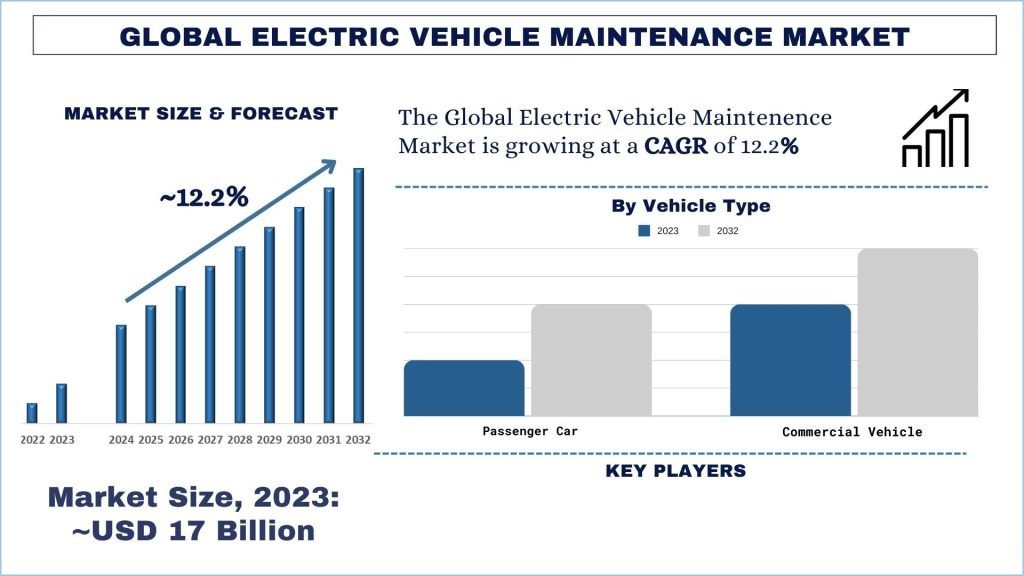 Размер и прогноз рынка технического обслуживания электромобилей
Размер и прогноз рынка технического обслуживания электромобилей
В 2023 году объем рынка технического обслуживания электромобилей оценивался примерно в 17 миллиардов долларов США, и ожидается, что в течение прогнозируемого периода (2024-2032 гг.) он будет расти со значительным среднегодовым темпом роста около 12,2% благодаря растущему распространению электромобилей и правительственным инициативам по сокращению выбросов.
Анализ рынка технического обслуживания электромобилей
Процесс технического обслуживания электромобилей во многом отличается от технического обслуживания автомобилей с двигателем внутреннего сгорания. В электромобилях меньше движущихся компонентов, чем в автомобилях с двигателем внутреннего сгорания, поэтому они не нуждаются в большинстве видов регулярного технического обслуживания, таких как замена масла, замена свечей зажигания или проверка системы выпуска. Однако техническое обслуживание электромобилей в основном касается аккумуляторной батареи, которая имеет решающее значение для функционирования автомобиля. Для поддержания аккумулятора в надлежащем состоянии необходимо регулярно заряжать его, а также контролировать температуру. Тем не менее, в электромобилях есть и другие компоненты, которые нуждаются в обслуживании, но не так часто, как в обычных автомобилях, такие как тормоза, шины и подвеска, среди прочих деталей.
Рынок технического обслуживания электромобилей (EV) переживает быстрый рост, обусловленный несколькими ключевыми факторами. Одним из основных драйверов является растущее распространение электромобилей во всем мире, подпитываемое государственными стимулами, экологическими проблемами и технологическими достижениями. Например, доля электромобилей в общих продажах увеличилась с примерно 4% в 2020 году до 18% в 2023 году. Ожидается, что продажи электромобилей продолжат оставаться высокими в течение 2024 года. По мере того как на дорогах появляется все больше электромобилей, растет спрос на услуги по их техническому обслуживанию. В электромобилях меньше движущихся частей, чем в традиционных автомобилях с двигателем внутреннего сгорания, но они требуют специализированного обслуживания из-за сложности их электрических силовых агрегатов и аккумуляторных систем. Эта сложность создает нишу для услуг по техническому обслуживанию электромобилей, включая проверку состояния аккумуляторов, обновления программного обеспечения и обслуживание электрических компонентов. Кроме того, развитие зарядной инфраструктуры и достижения в технологии электромобилей еще больше стимулируют рост рынка технического обслуживания электромобилей, поскольку потребители ищут удобные и надежные решения для обслуживания своих электромобилей.
Тенденции рынка технического обслуживания электромобилей
В этом разделе обсуждаются основные тенденции рынка, влияющие на сегменты рынка технического обслуживания электромобилей, выявленные нашими экспертами-исследователями.
Тип тяги, преобразующий промышленность
Ожидается, что в течение прогнозируемого периода (2024-2032 гг.) аккумуляторные электромобили будут расти со значительным среднегодовым темпом роста. В настоящее время основной причиной увеличения продаж BEV являются их экологические преимущества, поскольку они практически не выделяют парниковые газы, вызывающие изменение климата. Это связано с тем, что по мере того, как все больше потребителей и предприятий переходят на BEV, требуется все больше специализированных услуг по техническому обслуживанию для обеспечения эффективности этих транспортных средств. BEV имеют относительно меньшее количество компонентов, чем обычные двигатели внутреннего сгорания; однако аккумуляторы, используемые в BEV, представляют собой отдельные системы, которые требуют особого ухода и внимания для их эффективной работы и долговечности. Это включает в себя проверку состояния аккумулятора, его правильную зарядку, а иногда и замену аккумулятора. Этот фактор также включает в себя рост и инновации в технологической области диагностики и технического обслуживания BEV, что предоставляет рынку технического обслуживания электромобилей возможность для роста.
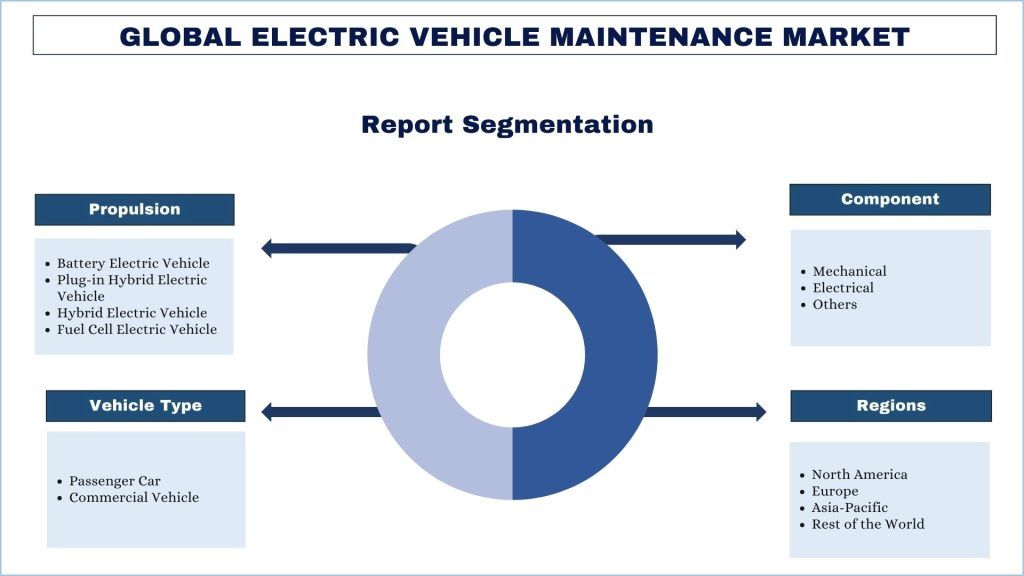
Ожидается, что Северная Америка будет расти со значительным среднегодовым темпом роста в течение прогнозируемого периода
Северная Америка занимает самую большую долю на этом рынке. Рост глобальных показателей использования экологически чистых транспортных средств, при этом потребительские тенденции благоприятствуют устойчивым видам транспорта, является основной причиной. Это также подпитывается государственными стимулами и правилами, которые поощряют низкий уровень выбросов парниковых газов с использованием электромобилей, что, в свою очередь, стимулирует спрос на адекватные решения для технического обслуживания электромобилей. Увеличение зарядной инфраструктуры упрощает использование электромобиля, что означает, что их продается больше, и, следовательно, они будут нуждаться в обслуживании и ремонте. Технологические изменения как аспект optima client всегда возникают, требуя постоянной настройки и специального предоставления услуг для поддержания электромобилей с высоким уровнем использования, поскольку электрификация всех коммерческих транспортных средств предъявляет более высокие требования к техническому обслуживанию. Кроме того, акцент на развитии послепродажного обслуживания помогает сохранить конкурентоспособность производства и поддерживать рост рынка благодаря более доступным и дешевым сервисным предложениям.
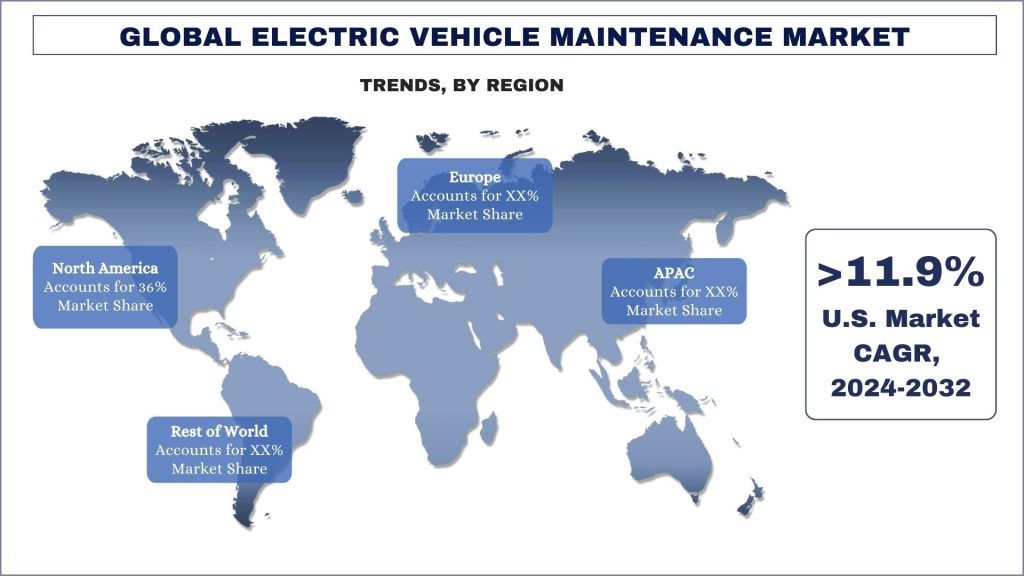 Обзор отрасли технического обслуживания электромобилей
Обзор отрасли технического обслуживания электромобилей
Рынок технического обслуживания электромобилей является конкурентным, с участием нескольких глобальных и международных игроков рынка. Ключевые игроки используют различные стратегии роста для повышения своего присутствия на рынке, такие как партнерства, соглашения, сотрудничество, запуск новых продуктов, географическое расширение, а также слияния и поглощения. Некоторыми из основных игроков, работающих на рынке, являются Robert Bosch GmbH, Hyundai Motor Company, The Hybrid Shop, HEVRA Europe OÜ, YCC Service Center, RAD AIR COMPLETE CAR CARE, SK Innovation Co. Ltd, LKQ Corporation, Axalta Refinish и GM Certified Service.
Новости рынка технического обслуживания электромобилей
- В июле 2022 года Hyundai провела в Сеуле семинар «EV Tech Lab», посвященный техническому обслуживанию электромобилей.
- В марте 2023 года компания Earthling Automotive объявила о включении услуг по техническому обслуживанию электромобилей в свой портфель для района залива Сан-Франциско.
- В марте 2024 года компания Meineke Car Care Center объявила об открытии своего первого в истории центра обслуживания электромобилей, который призван удовлетворить растущий спрос в штатах Каролина, в Индиан-Ленд, Южная Каролина.
Обзор отчета о рынке технического обслуживания электромобилей
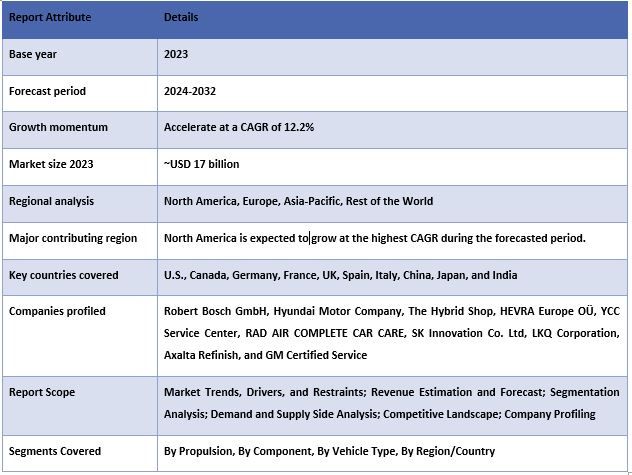
Причины купить этот отчет:
- Исследование включает в себя анализ размеров рынка и прогнозирование, подтвержденный проверенными ключевыми экспертами отрасли.
- В отчете представлен краткий обзор общей производительности отрасли с первого взгляда.
- Отчет охватывает углубленный анализ выдающихся игроков отрасли с уделением особого внимания ключевым финансовым показателям бизнеса, портфелям продуктов, стратегиям расширения и последним разработкам.
- Подробное изучение драйверов, ограничений, ключевых тенденций и возможностей, преобладающих в отрасли.
- Исследование всесторонне охватывает рынок по различным сегментам.
- Углубленный анализ отрасли на региональном уровне.
Варианты настройки:
Глобальный рынок технического обслуживания электромобилей может быть дополнительно настроен в соответствии с требованиями или любым другим сегментом рынка. Кроме того, UMI понимает, что у вас могут быть свои собственные бизнес-потребности; поэтому не стесняйтесь связаться с нами, чтобы получить отчет, который полностью соответствует вашим требованиям.
Содержание
Методология исследования рынка технического обслуживания электромобилей (2022-2032 гг.)
Анализ исторического рынка, оценка текущего рынка и прогнозирование будущего рынка глобального рынка технического обслуживания электромобилей были тремя основными этапами, предпринятыми для создания и анализа внедрения технического обслуживания электромобилей в основных регионах мира. Было проведено тщательное вторичное исследование для сбора исторических данных о рынке и оценки текущего размера рынка. Во-вторых, для подтверждения этих данных были приняты во внимание многочисленные выводы и предположения. Кроме того, были проведены исчерпывающие первичные интервью с отраслевыми экспертами по всей цепочке создания стоимости глобального рынка технического обслуживания электромобилей. После принятия и подтверждения рыночных данных посредством первичных интервью мы применили подход "сверху вниз/снизу вверх" для прогнозирования полного размера рынка. После этого были приняты методы разбивки рынка и триангуляции данных для оценки и анализа размера рынка сегментов и подсегментов отрасли. Подробная методология описана ниже:
Анализ исторического размера рынка
Шаг 1: Углубленное изучение вторичных источников:
Было проведено детальное вторичное исследование для получения исторических данных о размере рынка технического обслуживания электромобилей из внутренних источников компании, таких как годовые отчеты и финансовые отчеты, презентации результатов деятельности, пресс-релизы и т. д., а также из внешних источников, включая журналы, новости и статьи, правительственные публикации, публикации конкурентов, отраслевые отчеты, базы данных третьих сторон и другие надежные публикации.
Шаг 2: Сегментация рынка:
После получения исторических данных о размере рынка технического обслуживания электромобилей мы провели детальный вторичный анализ для сбора исторических данных о рынке и долях для различных сегментов и подсегментов в основных регионах. В отчет включены основные сегменты, такие как тип привода, тип компонента, тип транспортного средства и регионы. Был проведен дальнейший анализ на уровне стран для оценки общего внедрения моделей тестирования в этом регионе.
Шаг 3: Факторный анализ:
После получения исторических данных о размере рынка различных сегментов и подсегментов мы провели детальный факторный анализ для оценки текущего размера рынка технического обслуживания электромобилей. Кроме того, мы провели факторный анализ с использованием зависимых и независимых переменных, таких как тип привода, тип компонента, тип транспортного средства и регионы рынка технического обслуживания электромобилей. Был проведен тщательный анализ сценариев спроса и предложения с учетом ведущих партнерств, слияний и поглощений, расширения бизнеса и запуска продуктов в секторе рынка технического обслуживания электромобилей по всему миру.
Оценка и прогноз текущего размера рынка
Определение текущего размера рынка: Основываясь на практически применимых данных, полученных на основе вышеуказанных трех этапов, мы пришли к текущему размеру рынка, ключевым игрокам на глобальном рынке технического обслуживания электромобилей и рыночным долям сегментов. Все необходимые процентные доли и разбивки рынка были определены с использованием вышеупомянутого вторичного подхода и были проверены посредством первичных интервью.
Оценка и прогнозирование: Для оценки и прогнозирования рынка различным факторам, включая драйверы и тенденции, ограничения и возможности, доступные для заинтересованных сторон, были присвоены веса. После анализа этих факторов были применены соответствующие методы прогнозирования, т. е. подход "сверху вниз/снизу вверх", чтобы получить прогноз рынка на 2032 год для различных сегментов и подсегментов на основных рынках по всему миру. Методология исследования, принятая для оценки размера рынка, включает в себя:
- Размер рынка отрасли с точки зрения выручки (в долларах США) и темпы внедрения рынка технического обслуживания электромобилей на основных рынках внутри страны
- Все процентные доли, разбивки и детализация сегментов и подсегментов рынка
- Ключевые игроки на глобальном рынке технического обслуживания электромобилей с точки зрения предлагаемых продуктов. Кроме того, стратегии роста, принятые этими игроками для конкуренции на быстрорастущем рынке
Подтверждение размера и доли рынка
Первичное исследование: Были проведены углубленные интервью с ключевыми лидерами мнений (KOL), включая руководителей высшего звена (CXO/вице-президенты, руководители отдела продаж, руководители отдела маркетинга, руководители операционного отдела, региональные руководители, руководители стран и т. д.) в основных регионах. Затем были обобщены результаты первичных исследований и проведен статистический анализ для доказательства заявленной гипотезы. Данные первичных исследований были объединены с результатами вторичных исследований, превратив, таким образом, информацию в практически применимые данные.
Разделение основных участников в различных регионах
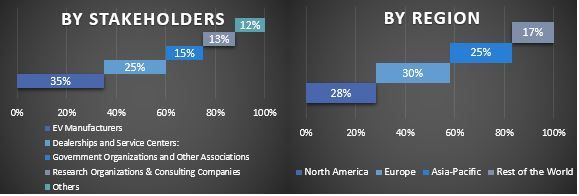
Инжиниринг рынка
Метод триангуляции данных был использован для завершения общей оценки рынка и получения точных статистических данных для каждого сегмента и подсегмента глобального рынка технического обслуживания электромобилей. Данные были разделены на несколько сегментов и подсегментов после изучения различных параметров и тенденций в типе привода, типе компонента, типе транспортного средства и регионах глобального рынка технического обслуживания электромобилей.
Основная цель исследования глобального рынка технического обслуживания электромобилей
В исследовании были точно определены текущие и будущие рыночные тенденции глобального рынка технического обслуживания электромобилей. Инвесторы могут получить стратегические данные, чтобы основывать свои решения для инвестиций на качественном и количественном анализе, выполненном в исследовании. Текущие и будущие рыночные тенденции определили общую привлекательность рынка на региональном уровне, предоставив платформу для участников отрасли, чтобы использовать неиспользованный рынок для получения выгоды от преимущества первопроходца. Другие количественные цели исследований включают:
- Проанализировать текущий и прогнозируемый размер рынка технического обслуживания электромобилей в стоимостном выражении (доллары США). Кроме того, проанализировать текущий и прогнозируемый размер рынка различных сегментов и подсегментов.
- Сегменты в исследовании включают области типа привода, типа компонента, типа транспортного средства и регионы.
- Определить и проанализировать нормативно-правовую базу для технического обслуживания электромобилей
- Проанализировать цепочку создания стоимости с участием различных посредников, а также проанализировать поведение клиентов и конкурентов в отрасли.
- Проанализировать текущий и прогнозируемый размер рынка технического обслуживания электромобилей для основного региона.
- Основные страны регионов, изученные в отчете, включают Азиатско-Тихоокеанский регион, Европу, Северную Америку и остальной мир
- Профиль компании на рынке технического обслуживания электромобилей и стратегии роста, принятые участниками рынка для поддержания быстрорастущего рынка.
- Углубленный анализ отрасли на региональном уровне
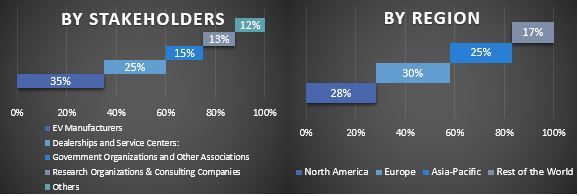
Часто задаваемые вопросы Часто задаваемые вопросы
Q1: Каков текущий размер и потенциал роста глобального рынка технического обслуживания электромобилей?
Q2: Какие движущие факторы способствуют росту глобального рынка технического обслуживания электромобилей?
Q3: Какой сегмент имеет наибольшую долю мирового рынка технического обслуживания электромобилей по типу транспортного средства?
Q4: Какие новые технологии и тенденции наблюдаются на мировом рынке технического обслуживания электромобилей?
Q5: Какой регион будет доминировать на мировом рынке технического обслуживания электромобилей?
Связанные Отчеты
Клиенты, купившие этот товар, также купили










